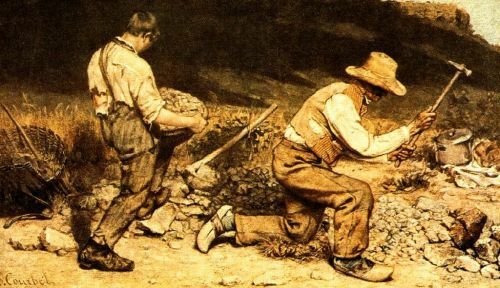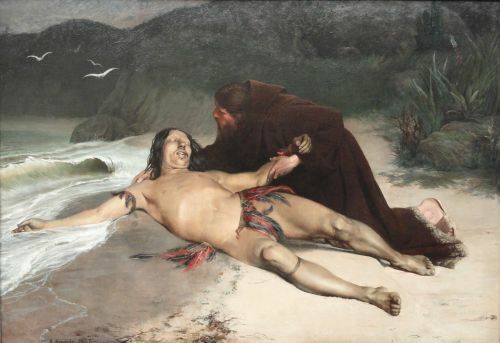O Realism was an artistic movement aimed at objective representation of reality, moving away from the subjectivism and sentimentality that characterized the romantic school.
The realist movement also played a very important role in the political scenario because, through several of its forms of expression (visual arts, literature, theater etc.), clearly portrayed the daily life of the bourgeois way and denounced various social problems such as poverty, labor exploitation and corruption.
Characteristics of Realism
The main characteristic of Realism is to show the facts in the most objective way, without excessively subjective, fanciful or idealizing approaches. That is why realism approaches scientific procedures, privileging reason and knowledge that comes from direct observation of phenomena. See below some of the main features of Realism:
- opposition to the central ideas of romanticism, such as subjectivism and the cult of the "I"
- objective approach to reality
- attempt at naturalistic reproduction of the world, people and objects
- privilege of reason and scientific knowledge
- use of common language
- approach to social and everyday issues
- preoccupation with the present
- absence of heroes: the stories are carried out by common people and not idealized people
- critical analysis of society
Learn more about characteristics of realism.
Historical context
Realism emerged in the mid-19th century in Europe, more specifically in France. This time was marked by the revolutions of 1848, which culminated in the emergence of the Second Republic in France.
This period was also marked by the deepening of the transformations of the Industrial Revolution. There were many innovations in the field of physics and chemistry. The use of electricity, oil and steel are some examples to be mentioned.
During this period, a technological revolution also took place, with the emergence of the telephone, the telegraph, steam engines, locomotives, etc.
It is important to mention the number of important works that appeared at that time, such as the Positive Philosophy Course, by Augusto Comte, and The Origin of Species, by Charles Darwin. Realism as an aesthetic movement is linked to the advancement of science and its methods.
realistic art
It was through artistic expression that the name of the movement emerged. In 1855, the French painter Gustave Coubert had his paintings prevented from participating in an exhibition called the Universal Exhibition, held in Paris, whose objective was to present the recent discoveries in the fields of agriculture, arts and industry, for having been considered offensive.
In retaliation for this censorship, Coubert organized his own exhibition near the Universal Exposition and called it “Le Réalisme” (Realism).

The stone breakers, by Gustave Courbet
In theatre, Realism conquered a notorious space when the themes became the portrait of reality. The text started to use the language of the people and no longer an extremely sophisticated language and the characters became ordinary people instead of heroes.
Realism in Brazil
The emergence of Realism in Brazil coincides with a period in which abolitionist laws came into force. These laws freed the slaves and replaced their labor with that of European workers, mainly Italians, to work especially on the coffee plantations.
At the same time, the monarchy was extinguished in Brazil and the country became a republic.
Within its philosophy of objective approach to everyday issues, Brazilian Realism has often portrayed in its works the crisis of the monarchy, abolitionist ideas and the reality of society.
The starting point of Realism in Brazil occurred with the publication of The Posthumous Memoirs of Bras Cubas, by Machado de Assis.
realism in Portugal
In Portugal, Realism was marked by the Coimbra Question, also called the Good Sense and Good Taste Question. This question consisted of a literary controversy between romantic writers led by Antônio Feliciano de Castilho and some students from the University of Coimbra, among them Eça de Queirós, Antero de Quental and Teófilo Braga.
The idea defended by the students was in favor of a more trustworthy literary approach in relation to reality and less conservative as preached by Realism. On the other hand, the Romantics advocated a more formal and traditional literary approach.
Authors and works
During Realism, many were the works that stood out. See below the list of some of these works and their respective authors.
- Madame Bovary, by Gustave Flaubert
- The Posthumous Memoirs of Bras Cubas, by Machado de Assis
- the cousin basil and The Crime of Father Amaro, by Eça de Queirós
- the mulatto, by Aluísio Azevedo.
- germinal, by Emile Zola
Realism and Romanticism
Realism emerged as opposition to Romanticism.
The ideas of Romanticism preached a reality full of dramas, utopia, tragedies and intense emotions. Realism, in turn, contrary to subjectivism and romantic idealism, had a more objective form of expression.

the last Tamoio, by Rodolfo Amoedo (Romanticism)
The realist ideal was to portray reality, sometimes even denouncing social problems in order to help the evolution of society.
See more about the Romanticism and read about The Types of Art.
Realism and Impressionism
Impressionism was a movement with an emphasis on plastic arts, especially painting, completely opposed to Realism.
Realist painting sought to reproduce on canvas the reality of society as it was. On the other hand, the impressionist considered that the artist should express himself without the concern to show a faithful portrait of reality.
Impressionist artists used to work outdoors to better capture how the different hues of the environment were reflected. They freely portrayed their perception of light reflections through loose brush strokes.

print, sunrise, by Claude Monet (Impressionism)
See more about the Impressionism.
realism and naturalism
Realism and Naturalism are directly linked by the common goal of expressing reality and portraying society in an objective way, sometimes even denouncing its problems.
Although Naturalism is a branch of Realism, its main characteristic is its own peculiarity: scientism.
For naturalists, what determines man is the environment that surrounds him and the biological characteristics received through heredity. This concept expresses the same idea as Chales Darwin's theory of evolution.
See more about Naturalism and Evolution theory.
See too:
- What was Romanticism?
- All about Romanticism.
